
Merseyrail is a hybrid commuter rail and rapid transit urban rail network serving the Liverpool City Region and adjacent areas of Cheshire and Lancashire. Merseyrail operates 68 railway stations across two lines – the Northern Line and Wirral Line, which are dedicated 750 V DC third rail electrified lines that serve underground stations in the centres of Liverpool and Birkenhead. Merseyrail branding is also applied to stations and 'shared' services on the City Line, which are within the Liverpool City Region but operated by other train operating companies. The City Line services operate on the Liverpool to Manchester Lines and the Liverpool to Wigan Line using a mix of AC electric and diesel trains. The total Merseyrail station count is 92 stations including the City Line.
Merseytravel is the passenger transport executive, responsible for the coordination of public transport in the Liverpool City Region in North West England. Merseytravel was established on 1 December 1969 as the Merseyside Passenger Transport Executive. From 1 April 2014, with the creation of the Liverpool City Region, Merseytravel expanded its area of operation from the metropolitan county of Merseyside to also include the Borough of Halton.
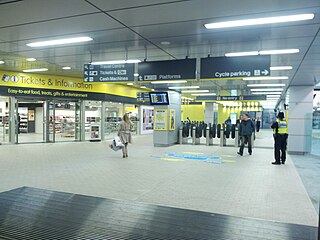
Liverpool Central railway station in Liverpool, England, forms a central hub of the Merseyrail network, being on both the Northern Line and the Wirral Line. The station is located underground on two levels, below the site of a former mainline terminus. It is the busiest station in Liverpool, though considerably smaller than Lime Street station, the mainline terminus, and the busiest station to operate fully the Merseyrail network. The station is the busiest underground station outside London serving 40,000 people daily. The station in passengers per platform is the busiest underground railway station in the United Kingdom at 5,217,547 per platform per annum and laying third in all stations, underground or overground.
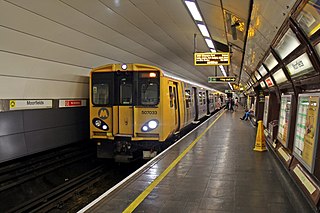
Moorfields railway station is an underground railway station in the city centre of Liverpool, England. The station is situated on both the Northern and Wirral Lines of the Merseyrail network. It is the third-busiest station on the Merseyrail network, and the largest underground station. It is also the only station on the network having services to all other Merseyrail stations.
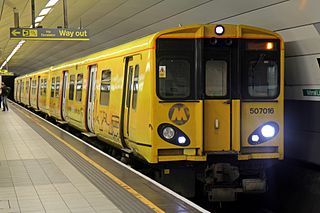
The British Rail Class 507 is a type of electric multiple-unit (EMU) passenger train built by British Rail Engineering Limited at Holgate Road carriage works in two batches from 1978 to 1980. They were the second variety of British Rail's standard 1972 design for suburban EMUs derived from PEP stock, which eventually encompassed 755 vehicles over five classes. They have worked on the Merseyrail network from new, and continue to do so, having been refurbished by Alstom's Eastleigh Works. The Class 507 units are all now 42 or more years old.

Burscough Junction pronounced is one of two railway stations serving the town of Burscough in Lancashire, England. It is sited on the Ormskirk Branch Line, 2+1⁄2 miles (4.0 km) north of Ormskirk and is served by Northern Trains. The station was the scene of the Burscough Junction Station Crash in 1880.

Ormskirk railway station in Ormskirk, Lancashire, England, is a cross-platform interchange between Merseyrail services from Liverpool Central and Northern Trains services from Preston on the Ormskirk branch line, 12+3⁄4 miles (20.5 km) northeast of Liverpool. The station building and three arch road bridge are both Grade II listed structures.
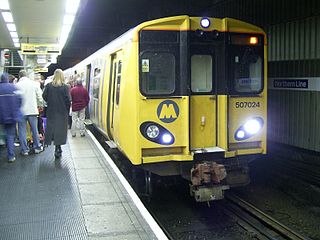
The Merseyrail Northern line is a cross-city railway running from Hunts Cross in south Liverpool then to termini in the north at Southport (Merseyside), Ormskirk (Lancashire) and Kirkby (Merseyside). It and the Wirral Line are commuter rail services operated by Merseyrail, serving Merseyside. A third line, the City Line, is not owned or operated by Merseyrail, although stations inside Merseytravel's area are branded as Merseyrail. All three lines are funded by Merseytravel.

The Wirral line is one of two commuter rail routes operated by Merseyrail and centred on Merseyside, England, the other being the Northern line.

The Canada Dock Branch is a 4-mile 59 chain long railway line in Liverpool, England. The line's route is from the large Edge Hill rail junction in the east of Liverpool to Seaforth Dock to the north. The line was originally built by the London and North Western Railway terminating at Canada Dock, with a later branch extension added to Alexandra Dock and links onto the MDHC railway lines. The line is not electrified.
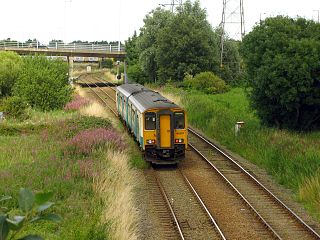
The Borderlands line, also known as the Bidston–Wrexham or Wrexham–Bidston line, is a railway line between Bidston on the Wirral Peninsula in England and Wrexham Central in the north-east of Wales. Passenger train services are part of the Wales & Borders franchise and are operated by Transport for Wales Rail. The line connects to the Merseyrail network at Bidston, the North Wales Coast Line at Shotton and the Shrewsbury–Chester line at Wrexham General. Parts of the line in Wales are used by freight trains, serving Deeside Industrial Park and the Hanson Cement works to the south of Buckley.
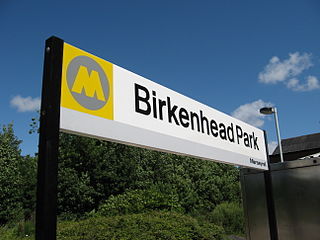
Birkenhead Park railway station is a two-platform through station situated in Birkenhead, Wirral, England. It lies on the Wirral Line 3+1⁄2 miles (5.6 km) west of Liverpool Lime Street on the Merseyrail network.

Burscough Bridge railway station is one of two railway stations which serves the town of Burscough in Lancashire, England. It is on the Manchester-Southport Line. It is operated and managed by Northern Trains. A bus interchange has recently been constructed next to the station, including a shop and cafe. The station has been identified by Merseytravel as a possible interchange between the Liverpool to Ormskirk line and the Southport to Wigan line in its Liverpool City Region Long Term Rail Strategy.

The British Rail Class 502 was a type of electric multiple-unit passenger train, originally built by the London, Midland and Scottish Railway at its Derby Works. Introduced in 1940 and withdrawn by 1980, they spent the whole of their working lives on the electrified railway lines north of Liverpool.
The Ormskirk branch line is a railway line in Lancashire, England, running between Preston and Ormskirk. The train service is operated by Northern Trains, who usually operate class 150, 156, and 158 units. The line is the northern section of the former Liverpool, Ormskirk and Preston Railway; the line from Ormskirk to Liverpool is now part of Merseyrail's Northern Line. Prior to the introduction of the 1970–71 London Midland Region timetable, it was a secondary main line from Liverpool to Scotland, Blackpool, and Yorkshire. From 4 May 1970, however, the line was severed at Ormskirk. With express trains eliminated, stopping services at the village stations en route were improved, and have retained a similar frequency to this day.
The Merseyrail City Line is shown in red on the Merseyrail map. Essentially the City Line is 'shared' train services. When a commuter train, not operated by Merseyrail, enters the Liverpool City Region it essentially becomes a Merseyrail City Line service with stations given Merseyrail's yellow branding, signage and ticketing. All City Line services terminate at Liverpool Lime Street. The line covers the Liverpool City Region sections of the:

The Kirkby Branch Line is a branch railway line from Wigan to Kirkby. The line's original route was from Liverpool to Bury and later the most northern of the Liverpool to Manchester lines. The line was split at Kirkby in 1977 with the western section forming a high frequency branch of the electrified Merseyrail Northern Line, also referred to as the Kirkby branch line. The Kirkby branch to Wigan remained a low frequency diesel operated service by Northern Trains from Kirkby to Manchester.
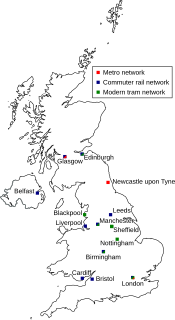
Urban or suburban rail plays a key role in public transport in many of the United Kingdom's major cities. Urban rail refers to the train service between city centres and suburbs or nearby towns that acts as a main mode of transport for travellers on a daily basis.
The Lancashire and Cumbria Route Utilisation Strategy is a Route Utilisation Strategy, published by Network Rail on 29 August 2008 It was the ninth RUS to be produced.














